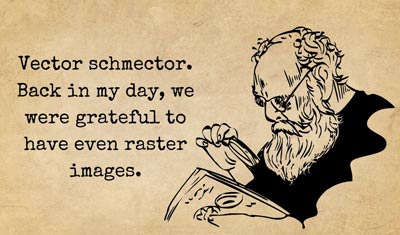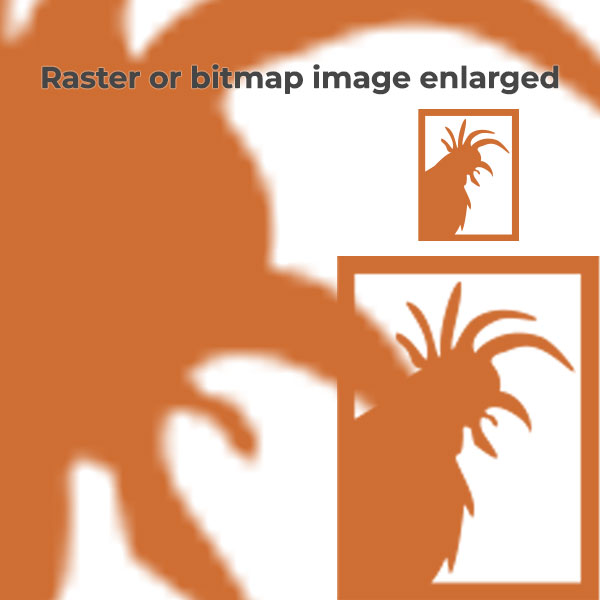Why do I need a vector logo?
Yep, I hear you. "I've done just fine so far, why do I need a vector logo?" I also hear you over there, yeah you, in the shirt, "What's a vector logo?"
You are in luck, because I can answer both of those questions!
Once upon a time in the land of the internets, average computer screens were 640x480 pixels, large computer screens were 800x600, and really big screens were 1024x768. Remember those days? Back then, raster (also called bitmap) images were fine for just about anything a small business might need to accomplish on the Internet.

Okay, so let's first figure out what raster and vector image are, and how they differ.
Raster or bitmap images
Raster/bitmap image files are stored as pixel information, e.g., the pixel at this location has this RGB value and the pixel at this location has this RGB value. The more pixels you have, the higher the resolution, and the larger the file size. This is how digital photographs are stored. Since neighboring pixels in a photograph are not usually the exact same color, it makes sense to store photographs as bitmaps. When you reduce or enlarge a raster/bitmap image, the pixel information is either cut (reduction) or multiplied (enlargement). This becomes more of an issue when you want to make a bitmap larger. It'll become 'pixelated' or blurry if enlarged by more than about 50%. Some bitmap common file formats: JPG, GIF, TIF, PNG, BMP, WEBP.
Raster images are still the backbone of the Internet, as they can display on any device.
Vector images
Vector image files, by contrast, are essentially stored as math--as numbers that describe the angle, curve, placement and arc of paths, and which RGB value, if any, is on which side of the path. And because all those numbers can be easily multiplied or divided by any value, the resulting image is crisp and clear at any size. These files are best for low-color graphics that will be needed both large and small, like logos. Some common vector file formats: SVG, EPS, WMF, CDR, AI.
Vector files can be used for any size project, from beads and buttons to vehicle wraps.
Visual Comparison
I started with the same size image, one raster, one vector, and enlarged them equally. You can see the difference in the images below. You can see how the edges get fuzzy, then obviously pixelated in the raster/bitmap image. Compare that to how crisp the lines remain in the vector version:


Technology continues toward bigger screens
Today, we have much larger, higher resolution screens. 1920x1080 is now on the small side for desktop and laptop computers. Web professionals are designing for both handheld devices and 4K screens. And brands that look crisp large and small ultimately look more professional.
So how does one GET a vector logo?
If you already have a logo that you're pretty sure is NOT vector:
- If someone else designed your logo, a vector version might actually exist. Contact your designer and ask for the vector files.
- Recreate your logo using a vector program (Inkscape is freeware, see our post on Low Budget No Budget Marketing).
- Have someone else recreate your logo using a vector program. Depending on the logo, we can probably do that--contact us to see.
- Consider refreshing your brand with a new logo.
If you don't have a logo, or are ready to refresh your brand:
- Create your logo using a vector program. Inkscape is a robust offline freeware vector-creation program (see our post on Low Budget No Budget Marketing). Canva Pro can also create vectors, but you must download as SVG. Keep in mind that if you can create it in Canva Pro, so can any other Canva Pro user.
- Have a professional designer create a custom vector logo tailored just for you. Contact us to discuss ideas!

